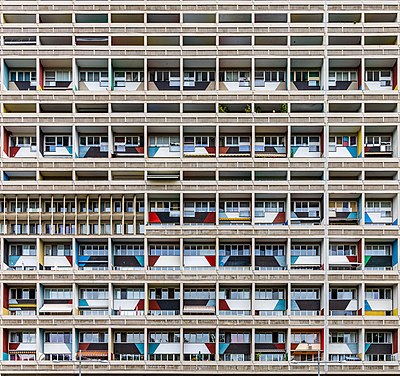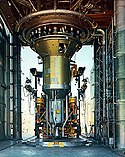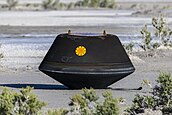Wikipedia:Main Page history/2023 September 28
From today's featured article
The Nuclear Engine for Rocket Vehicle Application (NERVA) was a rocket engine development program intended to establish a technology base for nuclear thermal rocket systems for space missions, as this promised to be more efficient than chemical rockets. NERVA was a joint effort of the Atomic Energy Commission and NASA, and was managed by the Space Nuclear Propulsion Office (SNPO). NERVA was considered a successful program in that it met or exceeded its program goals and demonstrated that nuclear thermal rocket engines were a feasible and reliable tool for space exploration. At the end of 1968 the SNPO deemed that the latest NERVA engine, the XE (pictured), met the requirements for a human mission to Mars. It had strong political support but was canceled by President Richard Nixon in 1973. Although NERVA engines were built and tested largely with flight-certified components and were deemed ready for integration into spacecraft, they never flew in space. (Full article...)
Did you know ...
- ... that Jonathan Allen (pictured) left journalism for politics before quitting 40 days later?
- ... that the Dvorichna settlement hromada has remained divided between Russia and Ukraine since the 2022 Kharkiv counteroffensive?
- ... that Chanig ar Gall joined her husband Charlez ar Gall in Breton-language broadcasting after learning the language itself?
- ... that South Korean band Seventeen partnered with Apple to let fans create remixes of their song "Darl+ing" on GarageBand?
- ... that tickets on secondary markets for the 2023 Leagues Cup final ranged from $484 to $12,000 within a day of release?
- ... that 13 contemporary Dubliners reenacted The Last Supper by Leonardo da Vinci for a mural installed in their city's "Italian Quarter"?
- ... that Chaimas Kaplanas took part in four hunger strikes during his imprisonment at Kaunas Prison?
- ... that a reviewer for The Sims 2: Nightlife said that a more accurate name would be "The Sims: Slutting About"?
In the news
- The OSIRIS-REx spacecraft mission returns samples of asteroid Bennu to Earth (return capsule pictured).
- Tigst Assefa breaks the women's world record at the Berlin Marathon.
- The Ministry of Foreign Affairs of Poland is accused of involvement in a cash-for-visa corruption scandal.
On this day
- 235 – Pope Pontian resigned after being exiled to Sardinia, becoming the first pope to relinquish the position; he was reportedly beaten to death with sticks weeks later.
- 1066 – William the Conqueror and his fleet of around 600 ships landed at Pevensey, Sussex, beginning the Norman conquest of England.
- 1901 – Philippine–American War: Filipino guerrillas killed more than forty American soldiers in a surprise attack on the town of Balangiga on the island of Samar.
- 1928 – Scottish biologist and pharmacologist Alexander Fleming (pictured) discovered penicillin when he noticed a bacteria-killing mould growing in his laboratory.
- 1975 – An attempted robbery of Spaghetti House, a restaurant in Knightsbridge, London, turned into a six-day hostage situation.
- Rabbi Akiva (d. 135)
- Elizabeth Maitland, Duchess of Lauderdale (b. 1626)
- Florence Violet McKenzie (b. 1890)
- Guillermo Endara (d. 2009)
Today's featured picture

|
The Unité d'Habitation of Berlin is a 1958 apartment building located in Berlin, a seminal example of modernist architectural design. Designed by Swiss-French architect Le Corbusier, it embodies the principles of his concept of unité d'habitation, an innovative response to post–World War II urban-housing challenges. The building is distinguished by its functionalism and efficiency. It encompasses 530 modular residential units, distributed across seventeen floors. The exterior façade, seen here in 2021, is characterized by the employment of rough-cast concrete, with colors designed by Le Corbusier together with the painter Fernand Léger. Photograph credit: Matthias Süßen
Recently featured:
|
Other areas of Wikipedia
- Community portal – The central hub for editors, with resources, links, tasks, and announcements.
- Village pump – Forum for discussions about Wikipedia itself, including policies and technical issues.
- Site news – Sources of news about Wikipedia and the broader Wikimedia movement.
- Teahouse – Ask basic questions about using or editing Wikipedia.
- Help desk – Ask questions about using or editing Wikipedia.
- Reference desk – Ask research questions about encyclopedic topics.
- Content portals – A unique way to navigate the encyclopedia.
Wikipedia's sister projects
Wikipedia is written by volunteer editors and hosted by the Wikimedia Foundation, a non-profit organization that also hosts a range of other volunteer projects:
-
Commons
Free media repository -
MediaWiki
Wiki software development -
Meta-Wiki
Wikimedia project coordination -
Wikibooks
Free textbooks and manuals -
Wikidata
Free knowledge base -
Wikinews
Free-content news -
Wikiquote
Collection of quotations -
Wikisource
Free-content library -
Wikispecies
Directory of species -
Wikiversity
Free learning tools -
Wikivoyage
Free travel guide -
Wiktionary
Dictionary and thesaurus
Wikipedia languages
This Wikipedia is written in English. Many other Wikipedias are available; some of the largest are listed below.
-
1,000,000+ articles
-
250,000+ articles
-
50,000+ articles




